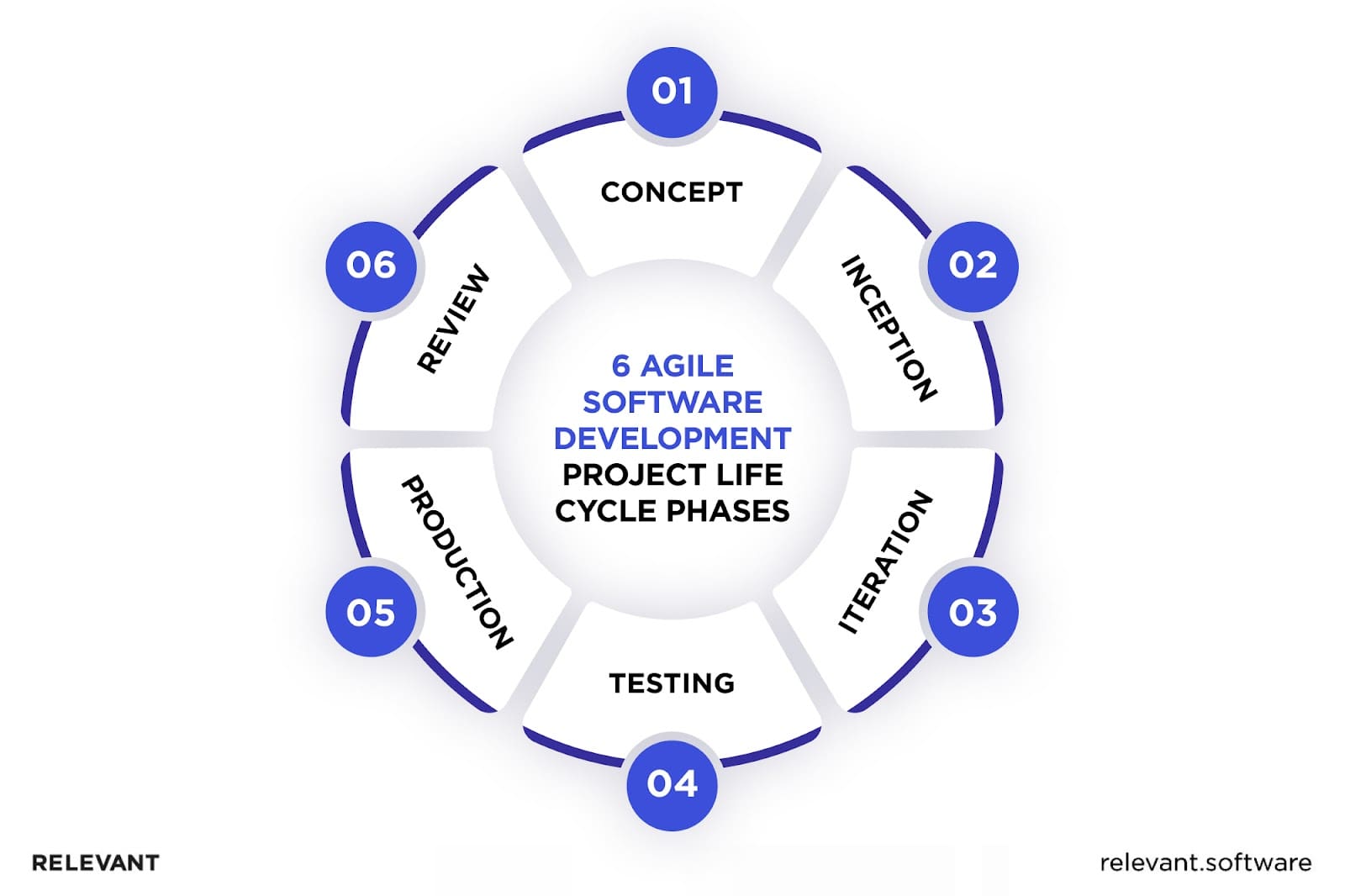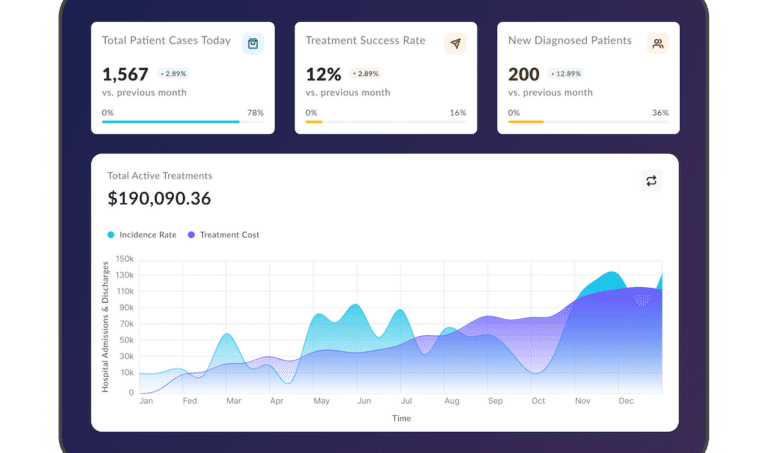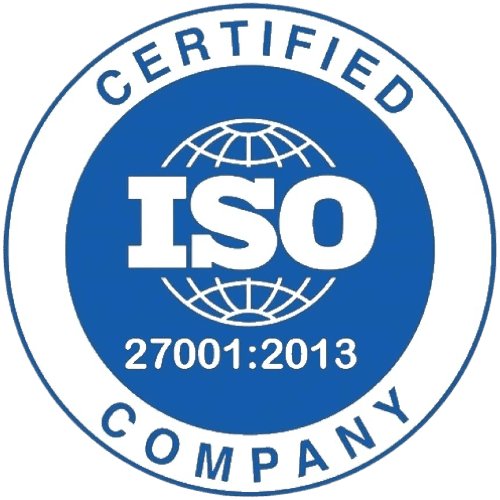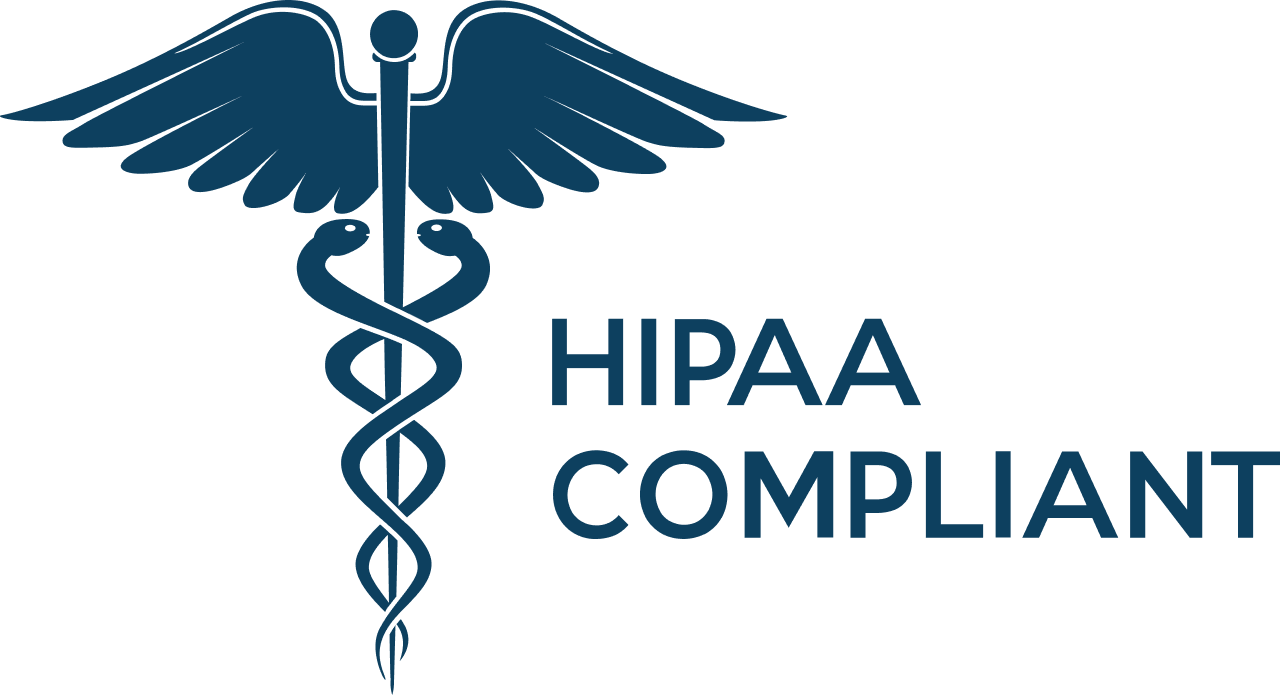Navigating the Agile Software Development Life Cycle: Phases, Tools, Roadmap
Updated: June 4, 2025
The agile software development life cycle remains a top priority for many businesses, with approximately 95% adopting it in some form or another. Noteworthy, Agile teams have shown a 37% faster profit increase and 30% higher revenue generation than non-Agile companies, primarily due to the improved speed, flexibility, and productivity that Agile approaches offer.
With these advantages, more organizations are turning to software product development services that incorporate Agile approaches, enabling them to stay in tune with market trends and customer needs. Moreover, the increased visibility highlights the importance of focusing on Agile tools and methodologies, particularly within the software development life cycle (SDLC).

We provide companies with senior tech talent and product development expertise to build world-class software. Let's talk about how we can help you.
Contact usThis article delves into the core aspects of Agile SDLC, highlighting how this iterative process fosters collaboration, innovation, and continuous improvement. By gaining an in-depth understanding of methodology, Agile SDLC phases, tools, and roadmap, you can harness the power of this transformative approach, enhancing your ability to respond to market shifts and deliver exceptional value to your customers.
Table of Contents
Why Agile?
Before diving into Agile’s particularities, it’s crucial to grasp what the Agile life cycle is and how it differs from the Waterfall methodology that previously dominated software development.
The Agile methodology emphasizes functional software over extensive documentation, personal communication over procedural tools, partnering with clients over formal agreements, and adapting to alterations over sticking to a blueprint. It focuses on providing incremental, usable software components that facilitate ongoing feedback and adjustments.
On the other hand, the Waterfall model follows a linear and progressive software development strategy. Each stage, including requirements analysis, design, coding, testing, and deployment, must be finalized before moving on to the next step. Changes are typically difficult to implement once a phase is completed, and there is little room for flexibility or iterative improvements.
A mere 9% of Agile projects experience failure, compared to a substantial 29% of projects that adhere to the Waterfall model.
What is meant by Agile SDLC?
So what is Agile software development? The Agile SDLC, or the Agile Software Development Life Cycle, is a project management methodology that prioritizes iterative and adaptable software development, customer involvement, and team collaboration. It aims to deliver functional software products in small increments while incorporating feedback and making adjustments as necessary.
Agile software development revolves around iterative and time-boxed cycles called sprints. Typically lasting two weeks, each sprint focuses on a set of “user stories” or features the team can deliver within the time frame. This approach allows for a more manageable product development and release cycle than the more extensive features in a waterfall project.

The Agile team maintains a modest size, consisting of no more than 12 participants, such as developers, analysts, QA specialists, the product proprietor, and the Scrum Master, who assumes the role of the project overseer.
What advantages does Agile offer for your businesses?
Agile project management follows the Pareto principle, where 20% of the effort produces 80% of the results. With the Agile SDLC process, teams deliver 80% of the product in just 20% of the time, focusing on the crucial software functionalities that bring real value to clients. The advantages of Agile are evident and straightforward. It provides:
- Agile delivery and functional demonstration
- Minimal resource requirements
- A pragmatic strategy for developing software
- Efficient teamwork and skill-sharing
- Flexibility to adjust to evolving conditions and needs
- Early delivery of partially functioning solutions
- Minimal rules and simple documentation
- The potential for parallel development and delivery within a familiar context
- Simple management and outstanding adaptability
The Basic Concepts of Agile Software Development Life Cycle
Agile development has its roots dating back to 1957 when Bernie Dimsdale, John von Neumann, Herb Jacobs, and Gerald Weinberg utilized incremental development techniques (now known as Agile) for IBM and Motorola. While they recognized its differences from the Waterfall model, they did not have a classification for it.

Relevant provides full-cycle software product development services from market research and business analysis to design, development, and launch. We can help you build your product from A to Z. Contact us to get a quote.
Get a free quoteThe contemporary Agile approach was formally established in 2001 when 17 software development experts gathered to discuss alternative project management methodologies. The authors described an adaptable, streamlined, and collaborative methodology in the Manifesto for Agile Software Development. The Manifesto focuses on “discovering better ways of developing software” and outlines the fundamental principles of this innovative approach.
- Agile development’s utmost priority is ensuring customer satisfaction by promptly delivering valuable software.
- The adaptable nature of Agile processes provides a competitive edge for customers.
- Changing requirements are accommodated even at later agile software development stages.
- Working software is delivered in short intervals, typically within weeks or months, to show progress.
- Developers and employers engage in daily communication throughout the project.
- Motivated people work best in the right environment with proper support.
- Self-organizing teams are better equipped to create optimal requirements, architectures, and designs.
- In-person interaction continues to be the most efficient method for sharing information among development team members.
- Teams regularly review performance metrics and adjust performance accordingly.
- Agile software development is a sustainable process that emphasizes continuous improvement.
- Technical excellence and good design are crucial to ensure flexibility and adaptability.
- Keeping things simple and minimizing work in progress can help increase efficiency and productivity.
Top Agile Methodologies in Software Development
Agile software development does not constitute a single framework of methodologies but encompasses several project management frameworks. The following table overview some commonly used and well-documented frameworks for agile software development. Many organizations adopt and modify them to fit the needs of their agile processes.
| Agile Framework | Main Features |
| Scrum | Time-boxed sprints (1-4 weeks) Roles: Product Owner, Scrum Master, Development TeamArtifacts: Product and Sprint Backlog, Increment Events: Sprint Planning, Sprint Review, Sprint Retrospective, Daily Scrum |
| Kanban | Visual workflow (Kanban boards) Work-in-progress (WIP) limits A continuous flow of work Focus on minimizing cycle time |
| Scrumban | A hybrid of Scrum and Kanban Combines time-boxed sprints with WIP limits and continuous flow Flexible planning and process improvement |
| Lean Software Development | Elimination of waste Focus on delivering value to customers Continuous improvement and optimization Just-in-time (JIT) production |
| Dynamic Systems Development Method (DSDM) | Time-boxed and iterativeEight guiding tenets for the process Swift provision of a minimal viable product Ranking of necessities according to their business significance |
| XP (eXtreme Programming) | Emphasis on continuous feedback and improvement Frequent releases Pair programming Test-driven development (TDD) |
| Crystal | Agile methodologies based on project size and criticality Focus on communication, collaboration, and team interaction Lightweight and adaptable |
| Feature-Driven Development (FDD) | Model-driven, short iterations Features are small, client-valued functions Five-step process to develop and track features Emphasizes quality and timely delivery |
Agile teams typically use frameworks as a starting point for their transformation and customize elements to suit their specific requirements. Each framework has its own set of pros and cons, and what works for one team may not work for another.

Key 6 Stages of the Agile Software Development Life Cycle
In the Agile lifecycle, a product moves through a structured series of stages typically involving six Agile SDLC phases or agile iterations. Each of these Agile phases lasts from one to three weeks and includes:

Phase 1: Concept
At the onset of the Agile development life cycle, stakeholders and product owners join forces to outline the project’s scope and priorities. They scrutinize costs, projected completion time, desired features, and requirements to determine the project’s feasibility.
Phase 2: Inception
The inception phase is the second of six Agile development life cycle stages. During this phase, the founder selects the appropriate team members, assigns roles, and provides the necessary tools to begin development.
Before beginning the development phase, it is essential to establish a plan and define the core set of methods and templates for future development activities. This planning stage, known as the inception phase, consists of two parts.
- UI/UX design, where designers create a mock-up of the user interface and experience, thoroughly analyzing their competitors’ strengths and weaknesses.
- Product architecture, where the dedicated team discusses the most suitable tools to meet business requirements, including frameworks, containers, programming languages, etc.
At the end of this phase, the team and software structure is established, allowing you to move to the next stage.
Phase 3: Iteration
This phase typically lasts the longest and involves close cooperation between developers and UI/UX designers to ensure that all business needs and feedback are incorporated into the code. During this phase, the team works on the product backlog, completed through development sprints.
The iteration (or development) stage is fundamental to the agile approach, allowing the team to build a product with minimal features, with additional functionality added later. Once the development stage is complete, it’s time to conduct quality assurance activities, create technical documentation, and end the iteration.
Phase 4: Testing
After testing the digital product at the end of every sprint, the final testing phase is conducted to ensure the software operates flawlessly. The Agile life cycle incorporates various types of testing, including:
- Unit Testing: At this stage, the QA team separately evaluates each front-end and back-end component’s performance and functionality.
- Integration Testing: This phase merges different product parts to verify their compatibility.
- Acceptance Testing: Upon completing this phase, quality assurance specialists assess the digital solution’s adherence to end-user requirements.
- System Testing: The entire system is evaluated to ensure all components function properly. The QA team approves the next deployment phase if the tests are successful
The designated team conducts all these procedures to assess the code’s quality and the product’s ability to fulfill business objectives. After successfully passing all testing stages, it is time to release the product. By the way, if you’re seeking top-notch quality assurance services delivered by industry experts, don’t hesitate to contact us!
Phase 5: Release
In this phase, the primary objective is to deliver a dependable and efficient product that meets customers’ requirements. It is accomplished by conducting quality assurance testing to ensure the product is error-free and functions flawlessly upon release.
Once all the final testing and verification are completed, the product is prepared for launch. To help users become acquainted with the software, development teams frequently offer training on using it efficiently. When the dedicated team ends all the activities, they pass to the final phase.
Phase 6: Review
Once an Agile software development project reaches this stage, the focus shifts from striving for a triumphant launch to sustaining long-term triumph. The product has been released successfully, and customers frequently provide feedback, request new features, or interact with recent updates.
The development and operations teams and stakeholders are now tasked with providing continuous support for the application to ensure it operates effortlessly.
Agile Techniques and Tools
Software development methodologies are typically considered adaptive or predictive. Agile SDLC belongs to the adaptive subcategory, while the V-shape, Iterative, Waterfall, and Spiral models fall under the predictive approach. These models are tailored to suit different companies’ diverse development requirements and expectations.
V-shape SDLC
The V-shape Software Development Life Cycle is a linear software development approach emphasizing validation and verification. The process moves sequentially through stages, with each stage corresponding to a specific development phase. The V-shape model is so named because the project timeline resembles the shape of the letter “V,” with planning, design, and development stages on the left side and testing, integration, and deployment stages on the right.
Iterative SDLS
The Iterative Software Development Life Cycle is a cyclical approach to software development that emphasizes continuous improvement through repeated development, testing, and deployment cycles. The goal is to gradually refine the software product and address any issues that arise during each iteration. This method allows adjustment and responsiveness to evolving demands and client input.
Spiral SDLC
The Spiral Software Development Life Cycle is a hybrid approach that combines elements of the iterative, waterfall, and prototyping methodologies. It is structured around a series of development cycles, or “spirals,” each with four phases: planning, risk analysis, engineering, and evaluation. The spiral model suits complex, large-scale projects, allowing flexibility, risk management, and adaptability.
Waterfall SDLC
The Waterfall is a traditional, linear approach to software development. It comprises sequential phases: requirements analysis, design, implementation, testing, and maintenance. Each phase must be completed before the next one can begin, and there is little room for changes or revisions once a phase is complete. This method is less flexible and adaptable than Agile methodologies, but it can be more straightforward and predictable for certain projects.

Can Agile be combined with other methodologies?
Yes, Agile can be combined with other methodologies to create a hybrid approach that leverages the strengths of each method. Organizations may combine Agile with the Waterfall, Spiral, or V-shaped SDLC, depending on their specific needs and project requirements.
For example, a team might use the Waterfall method for the initial planning and requirements analysis stages and then switch to Agile for the design, implementation, and testing phases. The key to successfully combining methodologies is to remain flexible and adapt the process to suit the unique needs of each project. This is impossible without using some Agile tools like:
- Jira is a widely-used software that facilitates the tracking and managing of Agile projects. It streamlines the planning, monitoring, and software release processes for teams.
- Trello is a flexible project management tool with boards, lists, and cards to organize tasks and projects. Its straightforward interface and ease of use make it a popular choice among users.
- Asana is a versatile tool that can be applied to diverse projects, not limited to software development. Its clean and user-friendly interface encourages collaboration among team members.
- Basecamp emphasizes communication and teamwork among team members through its simple interface and various features like to-do lists, schedules, and file sharing.
- Wrike is an all-inclusive project management tool that offers task monitoring, resource management, and team collaboration features.
For those new to agile project management, it is recommended to familiarize themselves with the methodology’s guiding principles before utilizing any available tools.
Agile Roadmap
A roadmap is a strategic plan that outlines the agile software development process steps required to transition a software development team or organization to Agile methodologies. It guides teams and stakeholders, helping them visualize the path toward Agile adoption and ensuring everyone is aligned on the goals and expectations. The following are the primary stages involved in devising an Agile roadmap:
Define goals
The first step in creating an Agile roadmap is to define the organization’s goals and objectives for adopting Agile methodologies. These may include improving project delivery time, increasing customer satisfaction, or fostering a culture of continuous improvement. Clearly defining the goals helps guide the Agile transformation process and ensures everyone works toward the same goal.
Get management support
Successful Agile transformations require support from all levels of the organization, especially from upper management. This support can be demonstrated through a commitment to providing resources, removing organizational barriers, and participating in the Agile transformation process. Securing management support is crucial to the success of the Agile roadmap.
Develop a transformation roadmap
Creating a high-level plan outlining the steps and milestones required to implement Agile methodologies is one of the most crucial Agile methodology steps. This roadmap should include tasks such as team training, process changes, tool selection, and pilot projects. Consider using a phased approach to allow your organization to adapt gradually to the new methodologies and make necessary adjustments along the way.
Make a plan for three months
Creating a short-term plan for the first three months of the Agile transformation is essential in the spirit of Agile’s iterative approach. This plan should be realistic, achievable, and focused on improving the product. It ought to comprise precise tasks, timelines, and required resources to accomplish short-term objectives.
Adapt and learn
Agile practices prioritize constant growth and adaptability. Regularly assess progress, collect input from stakeholders and team members, and modify approaches accordingly. Conduct retrospectives to pinpoint areas for enhancement and devise action plans to tackle them. Be willing to iterate and enhance Agile processes over time.
Link actions to results
Measure the success of your Agile transformation by tracking key performance indicators (KPIs) linked to your defined goals. KPIs such as lead time, cycle time, customer satisfaction, and defect rates are illustrative examples. Periodically evaluate these indicators and leverage them for continuous improvement.
Provide transparency for everyone involved
Transparency is a cornerstone of Agile methodologies. Ensure that all team members and stakeholders have access to up-to-date information about project progress, roadmaps, and performance metrics. This can be achieved through tools like project management dashboards, regular status updates, and open communication channels. Providing transparency fosters trust, collaboration, and accountability throughout the organization.
How do Agile Methodologies Fit in the Remote Work Era?
Agile practices thrive in the age of remote work, enabling effective collaboration and communication within distributed teams: daily stand-up meetings and periodic sprint reviews aid in maintaining coherence and directing remote teams toward achieving project objectives. Additionally, the iterative nature of Agile allows teams to quickly adapt and change in response to changing circumstances, which is especially important in the rapidly evolving remote work environment.

Agile tools and software also facilitate remote work by enabling teams to collaborate, share files, and track progress in real-time from any location. Overall, Agile methodologies provide a flexible and adaptable approach to software development that is well-suited to the challenges of remote work.
Pros of a remote Agile team
There are various ways to increase the development capacity for your software project when needed urgently. You can collaborate with freelancers, engage a digital agency, recruit in-house technical staff, or hire a dedicated remote agile development team from another location. The benefits of having a remote Agile team comprise:
- Finding the best talent pool: With a remote Agile team, companies hire the most skilled and talented individuals without being restricted by location. This results in a team with greater diversity and tech abilities.
- Saving on costs: Companies can save on expenses such as office space, utilities, and other overhead costs when they work with remote teams. Furthermore, recruiting individuals from regions with a lower cost of living could result in lower wage costs.
- Better productivity: Remote work often improves productivity since team members experience fewer distractions and can concentrate in a more comfortable environment. The flexible nature of remote work also helps team members achieve a healthy work-life balance, increasing job satisfaction and motivation.
- Flexibility and adaptability: Agile teams operating remotely benefit from being more flexible and adaptable to sudden changes or obstacles since they’re accustomed to working in a dynamic and distributed environment.
- Better collaboration tools and technology: As remote Agile teams become more common, there has been a surge in the development of advanced collaboration tools and technologies. These tools help remote teams communicate effectively and work together seamlessly, making it easier for organizations to adopt Agile methodologies in a distributed environment.

Challenges of Agile SDLC application while collaborating with distributed teams
In light of recent events such as the war in Ukraine, supply chain failures, and an unstable global economic environment, companies have increasingly adopted Agile approaches to adapt and remain competitive. But every rose has its thorn, and Agile is no exception as it comes with its own set of challenges.
- Communication: Agile methodologies heavily rely on communication and collaboration among team members. Communication becomes more arduous when team members are dispersed across various locations and time zones. There may be language barriers, technological issues, or simply a lack of face-to-face interaction that can cause miscommunication and misunderstandings.
- Culture differences: Agile methodologies hinge on a culture of transparency, trust, and collaboration. However, different cultures may have unique work styles, communication styles, and values that can clash with the Agile approach. For example, some cultures may prioritize hierarchy and formal communication, while Agile methodologies emphasize autonomy and informal communication. Recognizing and accommodating these cultural differences is crucial to foster a successful Agile environment.
- Technology issues: Technology is a critical component of Agile SDLC, enabling team members to collaborate and communicate effectively. However, different team members may use different tools, and technological issues such as slow internet speed, unreliable software, and incompatible hardware can disrupt the workflow and cause delays.
- Team management: Effective management is crucial for distributed Agile teams to ensure alignment towards common goals and cohesive collaboration. However, managing a distributed team can be challenging, as leaders may not have visibility into what each team member is doing, and team members may feel disconnected from the rest of the team.
Case Studies: Agile SDLC in Action
For FirstHomeCoach, we applied Agile SDLC principles to build a scalable digital platform that helps first-time homebuyers create personalized plans, estimate costs, and monitor progress at every step of their property purchase. The flexibility and reliability of the Agile SDLC allowed for efficient adaptation and quick feedback loops, showcasing the strength of Agile in delivering scalable digital products. In its first year, FirstHomeCoach supported over 5,000 users, facilitating more than 25,000 property purchase plans and analyzing over 200,000 data points. Additionally, more than 1,000 users utilized the mobile app to streamline their homebuying experience.
In the Volkswagen Genser App project, our goal was to develop a highly engaging React native app that combined marketing strategies with gamification, allowing users to earn points or discounts by collecting kilometers tracked via special beacons. We adopted an Agile SDLC approach to tackle this project, which required careful planning, constant collaboration, and iterative improvements. The result was a cross-platform app that elevates the user experience through intuitive design and efficient functionality. By adhering to agile methodology phases enabled us to adapt quickly to evolving project requirements and delivering a high-quality product that exceeds client expectations.
For RED Driver Training, the UK’s leading driving school, we were tasked to design and build a brand new app that fully aligns with their branding and operational needs and empowers the driving school and new drivers. Our Agile team worked iteratively with RED, focusing on constant feedback and collaboration to ensure the app not only met their business needs but also aligned seamlessly with their brand identity. By maintaining regular communication and adapting to evolving requirements, we successfully delivered a comprehensive learning platform that supports learners throughout their entire driving journey, from theory to practice.
Agile Software Development Life Cycle: Bottom Line
Agile methodologies have gained widespread adoption, and organizations that embrace them can dominate their industries, while those that don’t risk losing customers and top talent. Therefore, Relevant, as an experienced software development company, prioritizes the Agile software development life cycle and emphasizes adaptability to deliver customized solutions that meet each client’s specific needs. Our team values transparent communication and client involvement, ensuring progress updates and feedback throughout development to guarantee exceptional results.
So, if you’re a firm believer in the potential of Agile and are looking to harness it to develop your product, our software development company is the perfect partner for you. With our expertise, unwavering commitment to Agile methodologies, and emphasis on transparent communication, we’re dedicated to delivering software solutions that exceed your expectations. Ready to adopt Agile for your next software project? Get in touch with us to explore how we can help drive success for your business.
FAQ
Our core services:
Do you want a price estimate for your project?
Do you know that we helped 200+ companies build web/mobile apps and scale dev teams?
Let's talk about your engineering needs.
Write to us












